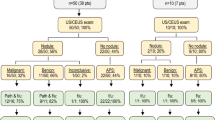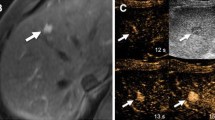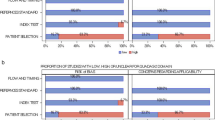Abstract
Purpose
To determine the added value of CEUS on arterial phase non-hyperenhancement (APNHE) observations (LR-3 and LR-4) of CT/MRI in high-risk patients.
Methods
Forty-three patients with APNHE observations (≥ 2 cm) from CT/MRI were prospectively enrolled in this IRB-approved study and underwent CEUS. All observations were assessed by LI-RADS for CT/MRI and CEUS. The hemodynamic findings were compared. The mean follow-up period was 11.8 ± 2.1 months. Reference standard was made on 34-APNHE observations based on biopsy (n = 2), surgery (n = 2), and follow-up image (n = 30).
Results
The median of observation size was 2.3 cm (IQR 2.0–2.5 cm). Among the 43-APNHE observations, 12-observations (27.9%) were further presented as arterial phase hyperenhancement (APHE) in CEUS with early (n = 1, CEUS LR-M), late (n = 10, CEUS LR-5), or no (n = 1, CEUS LR-4) washout. Compared to CT, CEUS presented concordant enhancement patterns in 16 (44.4%) in AP and 20 (55.6%) in PVP, respectively. Similarly, 13 (59.1%) and 14 (63.6%) observations showed concordant enhancement patterns between CEUS and MRI in AP and PVP, respectively. Of the 34-APNHE observations with final diagnosis (hepatocellular carcinoma [HCC] n = 12; intrahepatic cholangiocarcinoma [IHCC], n = 1; non-malignancy, n = 21), 4 HCCs (33.3%) and 1 IHCC (100%) were additionally diagnosed by CEUS, while 1 non-malignant lesion (4.5%) was misdiagnosed as HCC by CEUS.
Conclusion
Adding CEUS to APNHE observations from CT/MRI would be useful not only for definitely diagnosing HCC (CEUS LR-5) but also for other malignancies (CEUS LR-M). The discordance of dynamic features between the LI-RADS for CEUS and CT/MRI may reflect the different properties of contrast media, although the systems are not interchangeable.




Similar content being viewed by others
Abbreviations
- AP:
-
Arterial phase
- APHE:
-
Arterial phase hyperenhancement
- APNHE:
-
Arterial phase non-hyperenhancement
- CEUS:
-
Contrast-enhanced ultrasound
- CT:
-
Computed tomography
- DP:
-
Delayed phase
- HBP:
-
Hepatobiliary phase
- HCC:
-
Hepatocellular carcinoma
- LI-RADS:
-
Liver imaging reporting and data system
- MRI:
-
Magnetic resonance imaging
- PVP:
-
Portal venous phase
- SD:
-
Standard deviation
- US:
-
Ultrasound
References
Mitchell DG, Bruix J, Sherman M, Sirlin CB (2015) LI‐RADS (Liver Imaging Reporting and Data System): Summary, discussion, and consensus of the LI‐RADS Management Working Group and future directions. Hepatology 61:1056-1065
Marrero JA, Kulik LM, Sirlin C et al (2018) Diagnosis, staging and management of hepatocellular carcinoma: 2018 practice guidance by the American Association for the Study of Liver Diseases. Hepatology
Kielar AZ, Elsayes KM, Chernyak V, Tang A, Sirlin CB (2018) LI-RADS version 2018: What is new and what does this mean to my radiology reports? Abdominal Radiology:1–2
Takayasu K, Shima Y, Muramatsu Y et al (1986) Angiography of small hepatocellular carcinomas: analysis of 105 resected tumors. American Journal of Roentgenology 147:525-529
Takayasu K, Arii S, Sakamoto M et al (2013) Clinical implication of hypovascular hepatocellular carcinoma studied in 4,474 patients with solitary tumour equal or less than 3 cm. Liver International 33:762-770
Bolondi L, Gaiani S, Celli N et al (2005) Characterization of small nodules in cirrhosis by assessment of vascularity: the problem of hypovascular hepatocellular carcinoma. Hepatology 42:27–34
Rossi S, Ghittoni G, Ravetta V et al (2008) Contrast-enhanced ultrasonography and spiral computed tomography in the detection and characterization of portal vein thrombosis complicating hepatocellular carcinoma. European radiology 18:1749-1756
Jang H-J, Kim TK, Burns PN, Wilson SR (2015) CEUS: An essential component in a multimodality approach to small nodules in patients at high-risk for hepatocellular carcinoma. European journal of radiology 84:1623–1635
Wilson SR, Kim TK, Jang H-J, Burns PN (2007) Enhancement patterns of focal liver masses: discordance between contrast-enhanced sonography and contrast-enhanced CT and MRI. American Journal of Roentgenology 189:W7–W12
Elsayes K, Kielar A, Elmohr M et al (2018) White paper of the Society of Abdominal Radiology hepatocellular carcinoma diagnosis disease-focused panel on LI-RADS v2018 for CT and MRI. Abdominal radiology (New York) 43:2625
Elsayes KM, Hooker JC, Agrons MM et al (2017) 2017 version of LI-RADS for CT and MR imaging: an update. Radiographics 37:1994–2017
Kang H-J, Kim JH, Lee SM, Yang HK, Ahn SJ, Han JK (2018) Additional value of contrast-enhanced ultrasonography for fusion-guided, percutaneous biopsies of focal liver lesions: prospective feasibility study. Abdominal Radiology:1–9
Wilson SR, Lyshchik A, Piscaglia F et al (2018) CEUS LI-RADS: algorithm, implementation, and key differences from CT/MRI. Abdominal Radiology 43:127–142
Kono Y, Lyshchik A, Cosgrove D et al (2017) Contrast enhanced ultrasound (CEUS) liver imaging reporting and data system (LI-RADS®): the official version by the American College of radiology (ACR). Ultraschall in der Medizin-European Journal of Ultrasound 38:85–86
Lyshchik A, Kono Y, Dietrich CF et al (2018) Contrast-enhanced ultrasound of the liver: technical and lexicon recommendations from the ACR CEUS LI-RADS working group. Abdominal Radiology 43:861–879
Maruyama H, Takahashi M, Ishibashi H, Yoshikawa M, Yokosuka O (2014) Contrast-enhanced ultrasound for characterisation of hepatic lesions appearing non-hypervascular on CT in chronic liver diseases. The British journal of radiology
Burns PN, Wilson SR (2007) Focal liver masses: enhancement patterns on contrast-enhanced images—concordance of US scans with CT scans and MR images. Radiology 242:162-174
Chung YE, Kim KW (2015) Contrast-enhanced ultrasonography: advance and current status in abdominal imaging. Ultrasonography 34:3
Terzi E, De Bonis L, Leoni S et al (2017) CEUS LI-RADS are effective in predicting the risk hepatocellular carcinoma of liver nodules. Journal of Hepatology 66:S208–S209
Oosterveld B, Thijssen J, Hartman P, Romijn R, Rosenbusch G (1991) Ultrasound attenuation and texture analysis of diffuse liver disease: methods and preliminary results. Physics in Medicine & Biology 36:1039
Acknowledgement
We thank to Hyeon-Jin Kim (Seoul, Korea) for her assistance. We thank Bonnie Hami, M.A. (USA) for her editorial assistance in the preparation of this manuscript. We thanked Yoon Hee Choi in the Medical Research Collaborating Center (MRCC) (Seoul National University Hospital, Seoul, Korea) for her statistical assistance.
Funding
This research was partially supported by an academic research fund of the Korean Liver Cancer Study for 2017 and a research grant from SAMSUNG MEDISON Co., Ltd.
Author information
Authors and Affiliations
Corresponding author
Ethics declarations
Conflicts of interest
All authors confirm that no disclosure of potential conflicts of interest.
Ethical approval
This prospective study was approved by the Institutional Review Board of our hospital (IRB; No 1703-171-842), and all patients provided written informed consent for participation in this study.
Additional information
Publisher's Note
Springer Nature remains neutral with regard to jurisdictional claims in published maps and institutional affiliations.
Rights and permissions
About this article
Cite this article
Kang, HJ., Kim, J.H., Joo, I. et al. Additional value of contrast-enhanced ultrasound (CEUS) on arterial phase non-hyperenhancement observations (≥ 2 cm) of CT/MRI for high-risk patients: focusing on the CT/MRI LI-RADS categories LR-3 and LR-4. Abdom Radiol 45, 55–63 (2020). https://doi.org/10.1007/s00261-019-02132-x
Published:
Issue Date:
DOI: https://doi.org/10.1007/s00261-019-02132-x




